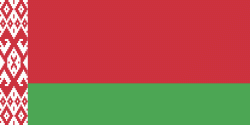Baranovichi
 |
The city of Baranavichy is located on the Baranavichy Plain in the interfluve of Shchara and its tributary Myshanka. Baranavichy is located virtually on the straight line, connecting regional centre Brest (206 km) and Minsk (149 km). Nearby cities: Lyakhavichy (17 km), Slonim (42 km), Nyasvizh (51 km), Navahrudak (52 km), and Hantsavichy (72 km). Baranavichy is located on flat terrain where the height difference does not exceed 20 m (from 180 to 200 m above sea level). The altitude of the city is 193 m above sea level. Total length of the city is 10 km from west to east and 7 km from south to north. The city is somewhat extended (by 8 km) in the southwest (from Brestskaya street) to the northeast direction (to Fabrichnaya street) and compressed (6.3 km) in the north (Sovetskaya street) to the southeast direction (Frolenkov street). Total area occupied by the city is 80.66 sq. km. (8066 ha as of 12 August 2012). The population density is more than 2,000 people per sq. km.
The northernmost point of the city is Korolik street located to the north of the plant Baranovichsky automatic lines at 53°10' north latitude, and the southernmost is village Uznogi located at 53°06' north latitude. The extreme western point is located in the vicinity of Badaka street at 25°57' east longitude, and the extreme eastern point is located in the vicinity of the intersection of Egorov street and Kashtanovaya street at 26°04' east longitude. The geometric centre of the city is Lenin square. In total, the city has about five hundred streets and lanes with the overall length of 252.8 km, 129.8 km of which are landscaped and 240 km are lit.
The city of Baranavichy is characterized by a favourable geographical position and is a major junction of the most important railways and highways. There is a close location of the main gas pipeline, a developed system of energy and water supply, and a favourable climate. A number of large industrial enterprises are located in the city.
As of 1 January 2019, 81,829 passenger cars are registered in Baranavichy. 146,678 adult residents live in the city. Thus, almost every second citizen of the city owns a passenger car.
The city of Baranavichy is not only one of the largest cities of the Republic of Belarus in terms of population (eighth largest in the country), but also one of the most important industrial, cultural and educational centres of Belarus.
At the beginning of the year 2010, Baranavichy had 21 sister cities, among which Russian Mytishchi (Moscow Oblast), Vasileostrovsky district of St. Petersburg, Finnish Heinola, Austrian Stockerau, Polish Biala Podlaska, Gdynia, Sulentsin povet, Chinese Chibi, Italian Ferrara, Latvian Jelgava, Ukrainian Poltava, Novovolynsk and others.
Map - Baranovichi
Map
Country - Belarus
 |
 |
| Flag of Belarus | |
Until the 20th century, different states at various times controlled the lands of modern-day Belarus, including Kievan Rus', the Principality of Polotsk, the Grand Duchy of Lithuania, the Polish–Lithuanian Commonwealth, and the Russian Empire. In the aftermath of the Russian Revolution in 1917, different states arose competing for legitimacy amid the Civil War, ultimately ending in the rise of the Byelorussian SSR, which became a founding constituent republic of the Soviet Union in 1922. After the Polish-Soviet War, Belarus lost almost half of its territory to Poland. Much of the borders of Belarus took their modern shape in 1939, when some lands of the Second Polish Republic were reintegrated into it after the Soviet invasion of Poland, and were finalized after World War II. During World War II, military operations devastated Belarus, which lost about a quarter of its population and half of its economic resources. The republic was redeveloped in the post-war years. In 1945, the Byelorussian SSR became a founding member of the United Nations, along with the Soviet Union.
Currency / Language
| ISO | Currency | Symbol | Significant figures |
|---|---|---|---|
| BYN | Belarusian ruble | Br | 2 |
| ISO | Language |
|---|---|
| BE | Belarusian language |
| RU | Russian language |















